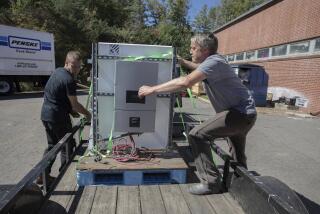Empowered, but Lacking Electricity
BAGHDAD — The situation in Iraq is such that every good thing that happens seems to have an accompanying bad.
Consider, for example, television. In Saddam Hussein’s Iraq, satellite dishes were a forbidden fruit. Now the walls are down, and the world is rushing in. In order to catch it, satellite dishes in a perplexing variety of sizes and quality are on sale on what seems like every street corner in Baghdad.
With them, one gains a brand-new view of the world. Provided, of course, that they are hooked up to televisions that work.
That’s the accompanying bad: TVs, like almost everything else in the modern world, require electrical power to run. And at the moment, one of the scarcest commodities in Iraq -- especially in Baghdad -- is a dependable source of electricity.
Iraq has had chronic power shortages for more than a decade. In 1990, the country’s total generating capacity was estimated at about 9,600 megawatts. Half that capacity was wiped out in the 1991 Persian Gulf War. What was left was a patchwork of old plants and, in many cases, older transmission lines. For the most part, nothing has been added since.
“It was decrepit, producing at half the level” of the period before the Gulf War, said Thomas Wheelock, a project manager for the U.S. Agency for International Development in Baghdad. “It was held together with chewing gum, rubber bands and the ingenuity of the Iraqi engineers.”
The United Nations estimated that production capacity had dwindled to 4,400 megawatts by last summer.
That was before this year’s war. Although physical infrastructure was not as heavily bombed by the U.S. as in 1991, some of it was struck. But the rampage of looting after the fall of the government did more damage than the war.
Pieces of the infrastructure have been found for sale as far away as Istanbul, Turkey. British military forces in the southern Iraqi city of Basra recently confiscated a copper smelter and tons of copper that had been stripped from transmission lines. They’ve also found barges full of copper being smuggled out of Iraq through the southern seaways.
Ian Pickard, a spokesman for the Coalition Provisional Authority in southern Iraq, said investigators there have concluded that in addition to the war and looting, there has been a concerted effort to sabotage the infrastructure.
“There was a demolition plan,” he said. As members of Hussein’s Fedayeen Saddam militia “moved out, they destroyed key sites. It wasn’t clear at the time. It’s clear now. It was systematic, and it was planned.”
The cumulative effect of all this shut down the power grid.
“By April, production was zero,” Wheelock said.
In the first two months after the war, as much of the old system as could be used was put back on line. Production was back to an estimated 3,300 megawatts by the middle of June, when transmission lines, oil pipelines and electric workers were hit by a wave of attacks.
The assaults occurred just as the summer weather arrived in full blast-furnace effect. The sabotage and the increased demand for electrical power, mainly for air conditioning and refrigeration, overloaded the fragile system and sent two-thirds of the country tumbling into darkness -- a very warm darkness.
For several days, the production at key plants in Baghdad was nonexistent.
“We were completely shut down,” said Bashir Khalaf Omar, director of the Baghdad South Power Station. In the midst of the blackout, he was reduced to crawling through the plant to try to determine how to get it restarted.
Still, in recent weeks, much progress has been made. The northern and southern sections of the country are back up and running. Baghdad, which produces less than a tenth of the nation’s energy and consumes more than half, has been hit harder. On an average day, most of the capital has no power half the time.
“It’s basically three [hours] on and three off,” Wheelock said.
This while average daytime temperatures are well over 100 degrees. Many nights it has “cooled” to about 90 degrees. People cope as best they can.
They wave fans over blocks of ice -- manual air conditioning, they call it. People sleep on rooftops.
Nearly every conversation -- no matter where it starts -- soon turns into one about electricity. People repeatedly say they cannot fathom how the U.S. with all its might cannot perform what they see as the simple act of repairing electric plants.
“We hoped the coalition would get electricity back the first week,” said Ali Hussein, a teacher.
“They’re old plants,” Wheelock said. “Because of a lack of spare parts, lack of maintenance and decades of disinvestments, not much of it is salvageable.”
In many ways, Baghdad’s powerlessness is a political decision. Natural gas plants in southern Iraq and hydroelectric plants up north produce most of the country’s electricity. In the past, by decree of the old regime, those two regions exported much of their production to Baghdad.
As a result, Baghdad’s 5 million people almost always had power. Meanwhile, the other 19 million Iraqis almost never had a day without blackouts.
Perhaps the only man in Baghdad who is not discouraged by the events is Tugrul Topcu, who, with his soft, rounded features and diffident manner, hardly seems the sort of man who would delight in others’ misery
But business is business, and Topcu’s business is very good. He sells power generators for a Turkish company, Aksa, that was among the first to seize on the opportunities presented by the faltering infrastructure.
Aksa rushed Topcu into Baghdad almost the moment President Bush declared an end to major hostilities.
He initially had much of the market to himself, but competitors have descended, and the city is awash in the rattle of small generators. Alleys are tangles of power lines where people have hacked into a neighbor’s power supply.
Still, business has been very good, he said. “When electricity is cut down,” he said, “the price goes up.”
More to Read
Sign up for Essential California
The most important California stories and recommendations in your inbox every morning.
You may occasionally receive promotional content from the Los Angeles Times.










